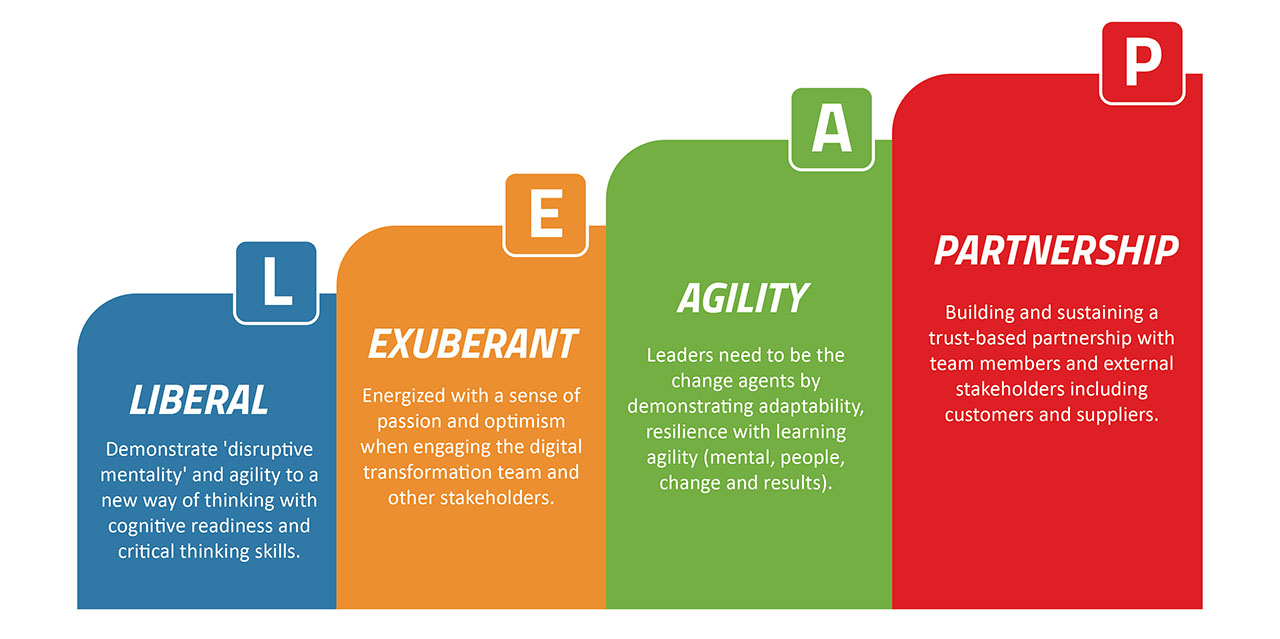To lead and manage the managerial challenges successfully in the VUCA-driven disruptive business environment, leaders need to “LEAP” through the fog and demonstrate the relevant leadership competencies and skills to navigate through the “fog” (see Figure 1).

Figure 1: “L.E.A.P.” through the Fog of VUCA World
Liberal
Leading in a disruptive environment means getting used to incredible levels of uncertainty. A leader will never know how something will work until he or she tries it. Modifying their assumptions and adapting or revising the plans depending on the desired results is the standard practice of the most highly effective disruptive leaders.
A leader’s mindset is the most powerful tool he or she has. It informs what a leader believes is possible, or impossible, and how he or she builds a path to achieve it. A leader’s experiences inherently inform his or her mindset, and sometimes that information can stifle or impede the ability to resolve business challenges. Mindsets are critical to creating any new reality (Bawany 2020).
Exuberant
Optimism refers to having a positive outlook or thinking positively. Optimistic leaders tend to see the good in people and organizations and believe in favorable results. They are simply able to see possibilities and seek opportunities.
Passion is a sense of energy for something. Leaders’ passion and purpose are their internal energy source, the fire or determination they have for reaching some destination up ahead. They tell a leader why he or she is on this journey and what they want from life. Passion and optimism can lift others beyond self-perceived limitations, which can then lead to team success during times of challenge, change, and even disappointment.
Agility
Leaders need to be change agents by demonstrating resilience with mental and learning agility. Learning agility is the ability and willingness to learn from every situation a leader goes through in life—including the ones where they have no idea what to do—and to find solutions by leveraging cognitive readiness and critical thinking skills. The inability to adapt proficiently has often been cited as the reason for leadership derailers.
Disruptive leaders know that the key to organizational success lies in using the insights from experimenting to chart a new direction. It doesn’t matter if the leader doesn’t understand what’s happened the first time his or her organization tries something new. If the leader keeps his or her eyes and ears open, he or she will be better informed the second time. That’s the hallmark of a disruptive leader (Bawany 2020).
Partnership
As disruptive leaders, aligning their words and actions is a crucial pillar for building trust in the workplace and, ultimately, for an organization’s success. The reality is that what leaders say and do has the most impact on their team member’s perception of an organization. When the leader’s words and actions are not congruent, team members are less likely to become engaged and committed to the organization.
It is also crucial to remove “silos” within organizations to ensure effective collaboration and involvement at every level (intra- and inter-team) to create a trust-based organizational climate that is needed to make the organization successful.
The leader should continuously develop these trust-based relationships by demonstrating his or her emotional and social intelligence competence and reliability by ensuring commitments or promises made are being honored or fulfilled as well as communicating key agreements and decisions. When leaders treat stakeholders like they would a valued client and take time to have one-to-one conversations and engage with them regularly, the leaders will earn respect and ultimately build robust and meaningful stakeholder relationships.
Conclusion
Navigating a VUCA environment requires a new kind of leadership, one that is visionary yet grounded, agile yet stable, and collaborative yet decisive. By fostering a culture of agility, understanding, and lifelong learning, leaders can not only navigate the VUCA landscape but can turn volatility, uncertainty, complexity, and ambiguity into opportunities for growth and development.
In conclusion, leading in a VUCA landscape is not about avoiding the chaos but mastering it, turning challenges into opportunities for growth and success. It is about building teams that are resilient, adaptive, and primed for the future, leading with vision and purpose in a world of constant change.

